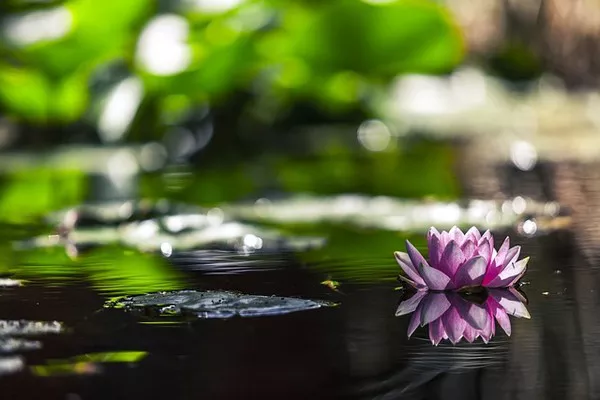A well-designed pond can be a captivating addition to any landscape, enhancing the beauty of your property and providing a tranquil oasis for both humans and wildlife. To truly make your pond flourish, planting aquatic vegetation is essential. Aquatic plants not only enhance the aesthetics but also play a critical role in maintaining water quality and creating a balanced ecosystem. In this comprehensive guide, we will walk you through the step-by-step process of planting plants in a pond, ensuring a thriving aquatic environment for years to come.
See Also: What Does an Underwatered Succulent Look Like?(Revealed!)
Understanding the Importance of Aquatic Plants
Before we dive into the practicalities of planting aquatic vegetation, it’s crucial to understand their importance in a pond ecosystem:
Water Filtration: Aquatic plants act as natural filters by absorbing excess nutrients such as nitrogen and phosphorous from the water, helping to prevent algae blooms and maintain water clarity.
Oxygenation: Through photosynthesis, aquatic plants release oxygen into the water, which is vital for the health of fish and other aquatic organisms.
Habitat and Shelter: Aquatic plants provide shelter and breeding grounds for fish and other aquatic species, promoting biodiversity within your pond.
Aesthetic Appeal: The right mix of aquatic plants can enhance the beauty of your pond, creating a visually pleasing and harmonious landscape.
Erosion Control: Plant roots stabilize the pond’s shoreline, reducing erosion caused by water movement.
Now, let’s explore the step-by-step process of planting aquatic vegetation in your pond.
Step 1: Assess Your Pond
Before you start planting, assess your pond’s conditions, including:
Water Depth: Different aquatic plants thrive at varying water depths. Measure the water depth at various locations in your pond to determine the appropriate planting zones.
Sunlight Availability: Consider the amount of sunlight your pond receives throughout the day. Some aquatic plants require full sun, while others prefer shade.
Soil Type: Assess the type of soil or substrate at the bottom of your pond. Different plants may require specific types of substrate or planting containers.
Water Quality: Check the water quality parameters such as pH, temperature, and nutrient levels to ensure they are suitable for aquatic plant growth.
Step 2: Choose the Right Plants
Selecting the appropriate aquatic plants for your pond is crucial for their success. There are three main categories of aquatic plants to consider:
Submerged Plants: These plants grow entirely underwater and help oxygenate the water. Examples include hornwort, anacharis, and Vallisneria.
Emergent Plants: Emergent plants have their roots underwater but grow above the water’s surface. They provide habitat and nesting areas for aquatic wildlife. Examples include cattails, bulrushes, and water lilies.
Floating Plants: These plants float on the water’s surface and provide shade, reducing algae growth. Examples include water hyacinth, water lettuce, and duckweed.
Choose a variety of plants from each category to create a balanced ecosystem within your pond.
Step 3: Prepare Planting Containers
Many aquatic plants can be planted directly in the pond’s substrate, while others require containers. To prepare planting containers:
Use plastic or fabric planting containers with holes for drainage.
Fill the containers with a specialized aquatic plant potting mix or a mix of loam and clay.
Place a layer of gravel or aquatic planting substrate on top to secure the plants and prevent the soil from floating away.
Step 4: Planting Submerged and Emergent Plants
For submerged plants:
Gently remove the plant from its nursery pot, taking care not to damage the roots.
Plant the submerged plant in the desired location at the appropriate depth, ensuring that the roots are covered with substrate.
Anchor the planting container or use rocks to secure the plant in place if necessary.
For emergent plants:
Partially fill the planting container with substrate.
Carefully place the emergent plant into the container, ensuring the crown (where the stems meet the roots) is slightly above the substrate.
Add more substrate to cover the roots and secure the plant.
Place the container in the desired location in the pond, ensuring it is partially submerged.
Step 5: Planting Floating Plants
Floating plants are the easiest to plant:
Simply release them onto the water’s surface, where they will naturally float.
Allow them to spread and cover the water’s surface as desired.
Step 6: Maintenance and Care
To ensure the long-term health of your aquatic plants and pond ecosystem, follow these maintenance and care guidelines:
Pruning: Regularly trim and remove dead or overgrown plant material to prevent overcrowding and maintain water circulation.
Fertilization: Some aquatic plants may benefit from specialized aquatic fertilizers. Follow the recommended guidelines for your specific plant species.
Pest Control: Monitor for pests such as aphids or snails that can damage plants. Use appropriate control measures if necessary.
Water Quality: Continuously monitor water quality parameters and make adjustments as needed to maintain the ideal conditions for plant growth.
Repotting: Over time, plants may outgrow their containers. Repot them as necessary to ensure healthy growth.
Weeding: Remove invasive or unwanted plant species to prevent them from taking over your pond.
Winter Preparation: In colder climates, consider moving potted plants to deeper water or overwintering them indoors to protect them from freezing temperatures.
Conclusion
Planting aquatic vegetation in your pond is not only aesthetically pleasing but also essential for maintaining a healthy and balanced ecosystem. By carefully selecting the right plants, preparing suitable planting containers, and providing proper care and maintenance, you can create a thriving aquatic environment that enhances the beauty and sustainability of your pond for years to come. So, roll up your sleeves, gather your planting materials, and embark on a journey to transform your pond into a vibrant and biodiverse oasis.


